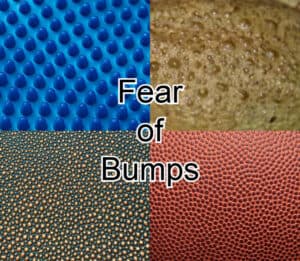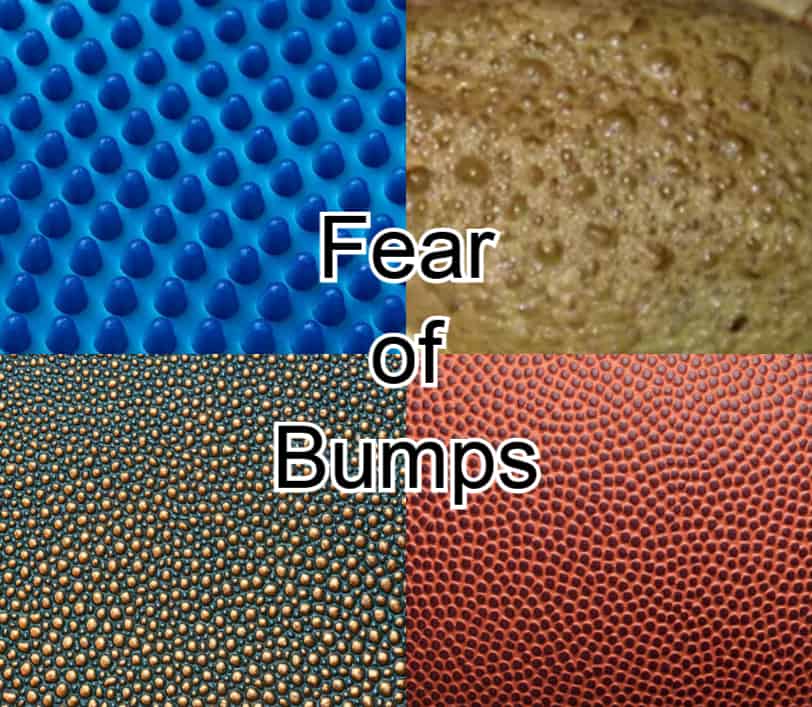Share This Article
Fear of Bumps – Scary for Some
Are you disgusted at the sight of holes, bumps, or clusters of holes like those in a honeycomb or sponge? Do you find yourself hyperventilating or nauseous when you come across images of bubble wrap or fruit seeds? Does the sight of Swiss cheese make you feel like running away?
If your answer is yes, you may be suffering from the fear of bumps and lumps clustered together.
Fearing bumps is more prevalent than previously thought, with a huge population suffering from it today. Some studies have shown that around 20 percent of people (including both children and adults) suffer from some degree of fear of bumps, although experts agree that a much larger population tends to have a repulsed reaction to such images.
So, of all the different kinds of phobias, it’s safe to say there’s a lot of awareness of the fear of bumps. This awareness makes it easier for someone suffering from bump fear to get help.
What Is a Fear of Bumps?
This relatively new phobia first came to light in 2005, leaving experts with a dilemma. Many are unsure if the fear of bumps is even a true phobia. Because of this, it’s not officially classified as a mental disorder.
Is the Fear of Bumps a Phobia of Fear or Disgust?
True phobias are defined as a state of constant fear, worry, or anxiety resulting from the trigger. The fear escalates so much that the affected person is not able to go on about his/her daily life. And as per the American Psychiatric Association (APA), the fear of bumps fails to meet these standards. That’s why it’s not currently categorized as a phobia in the Diagnostic and Statistical Manual of Mental Disorders (DSM).
But tell that to those who have been struggling with a fear of bumps in their daily lives.
The mere thought of seeing their phobia triggers can cause extreme anxiety or even panic attacks. And for others, the sight of such holes or bumps can trigger disgust, which makes them look away from such a sight. This repeated response can then become the root of the fear developing into a full-blown phobia.

So, what are the things that trigger a phobic reaction in people with a fear of bumps?
The triggers are:
- Honeycomb
- Cheese with holes
- Bubble wrap
- Skin of reptiles
- Fruits with a cluster of numerous small seeds, like raspberries, strawberries, papaya, and kiwi
- Head of a lotus flower
- Sponges
- Coral
- Condensation on surfaces
- Holes or pebbles on concrete
While anything with patterns of small holes can cause anxiety to someone with a fear of bumps, images of human body parts with holes or other patterns are the biggest trigger. It causes an irrational fear of picking up a disease or having a biological condition that may cause the body to rot.
Causes for Fear of Bumps
The exact cause of any phobia, including this bump phobia, cannot be determined. However, it is usually a combination of environmental and genetic factors that contribute to a person developing the fear.
Environmental factors could be a learned response from early life, childhood trauma, fear resulting from an epidemic or pandemic of infectious diseases like smallpox or measles, or battling with mental issues like long-term anxiety or depression, etc.
Genetic factors include a predisposition to mental issues, especially anxiety disorders.
Photos of bumps could be a triggering factor as well, initiating the onset of the phobia. Scientists believe that the contrasting imagery created by patterned designs elicits an unpleasant reaction. It could also be that the patterns initiate an adaptive response to “dangerous” patterns.
For example, a person who associates such patterns with deadly diseases has an adaptive response that makes them fear the pattern.
Clustered patterns may also remind someone of maggots or other small insects that live in groups and crawl over one another.
This fear may also be a part of social anxiety where the holes depict human eyes or faces searching through you, criticizing you, and finding faults. Such thoughts could initiate a fear-induced anxious reaction.
Fear of Bumps Symptoms
Fear of bumps initiates both physical and mental/emotional symptoms like those seen in most anxiety disorders. Here are some of the most common signs to watch for.
Physical Symptoms
- Nausea
- Sweating
- Trembling
- Fainting
- Shortness of breath
- Rapid heartbeat
- Dry mouth
- Goosebumps
- Crawling-like sensations on the skin
- Headache
Mental/Emotional Symptoms
- Anxiety
- Panic attack
- Feeling of dying
- Intense feelings of disgust or fear
- Helplessness
- Uneasiness
The fear of bumps is closely related to the fear of holes.
Treatment for Fear of Bumps
Like all other specific phobias, there is no one defined treatment for this fear. However, acknowledging your fear, talking about it, and reaching out for help can make a huge difference.
Here are some simple, effective steps you can take for a healthier you.
Self-Help
Self-help is one of the best ways to heal at your own pace. It equips you with effective methods to overcome your fear. Most self-help methods tend to use one or more of the following techniques:
- Journaling
- Relaxation techniques
- Yoga
- Meditation
- Deep breathing
- Exercise
- Exposure therapy
These techniques, when practiced regularly, help calm the mind and ground you. They help you rationalize your thoughts and alleviate symptoms, reducing anxiety.
Professional Help
Professionals are experts who encounter patients with phobias on a regular basis. They have the skills and expertise to help you overcome your fear of bumps.
After diagnosing your phobia and determining its severity, your doctor will use one or a combination of the following therapies to help you learn to better manage your fear:
- Exposure therapy
- Cognitive behavioral therapy
- Talk therapy
- Emotional freedom techniques (EFT)
Medication
In rare cases, when therapies have not yet taken effect and the person is having repeated panic attacks, medication may be prescribed to help with symptoms.
The most common medications used are:
- Antidepressants like benzodiazepines or selective serotonin reuptake inhibitors
- Beta blockers
These medications are only prescribed for a brief period, and will be tapered off once symptoms begin to calm down.
Learning to Cope with a Fear of Bumps
Whether fear of bumps is recognized or not, it is still difficult for some to deal with their anxiety related to bumps. Without treatment, it can affect one’s daily and professional life.
First, consider that you are suffering from an irrational phobia and there are ways to cope with it. Talk about your fear with loved ones. More importantly, seek advice from a professional who can help you understand and overcome this irrational fear.
Additionally, there are many self-help techniques like journaling, meditation, and exercise that go a long way.
Conclusion
While suffering from any phobia is not easy, a determination to get healthier will set you on the path to wellness. The fear of bumps can seem impossible to deal with, but there are solutions available to overcome this phobia. Talk with family and friends and reach out to professionals for a better tomorrow!



